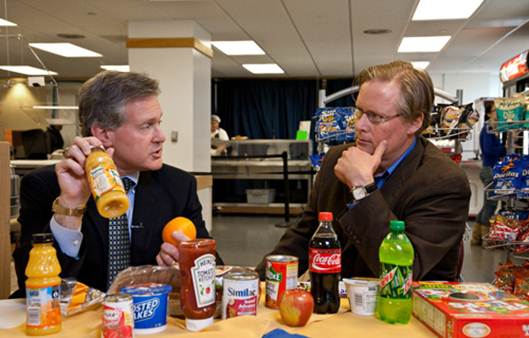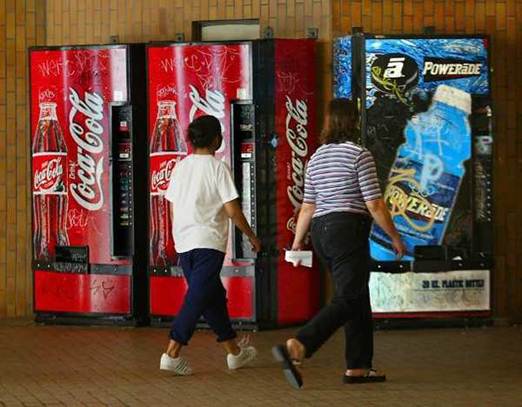The Other Side of the Story
Lustig’s idea sounds appealingly logical,
but many experts don’t buy his toxic-sugar theory. David Katz, M.D., M.P.H., is
one such expert. He has written and spoken extensively on the subject. “That
talk, what made it so viral was the extreme position,” says Katz, director of
the Yale University Prevention Research Center and an EatingWell advisor.
“Vilifying a certain nutrient is a good-versus-evil worldview. It’s easy to get
people excited if you say the most extreme thing.”

ABC
News Nightline correspondent John Donvan interviews pediatric endocrinologist
Robert Lustig about the dangers of consuming fructose
Though Lustig is a respected physician, he
isn’t a fructose researcher (he has only one original scientific paper on the
subject, based on government-generated not lab-generated data). Most of his
90-plus published scientific papers focus on overweight children. And before
his infamous lecture, only two mentioned fructose at all; since 2009, he’s
published six papers that mention fructose, mostly editorials, reviews and
commentaries on his theory.
But he’s not the only one to theorize that
fructose is causing some of our modern health problems. In 2004, George Bray,
M.D., at the Pennington Biomedical Research Center in Louisiana, and Barry
Popkin, Ph.D., at the University of North Carolina at Chapel Hill, noticed that
rising rates of obesity paralleled an increase in sugar consumption and they
loosely attributed this to the harmful way our body metabolizes fructose. Other
studies have since more strongly linked consuming sugar-sweetened beverages
like sodas and juices with obesity, at least in children and adolescents, and
for years researchers have been giving animals extremely high doses of fructose
to create metabolic syndrome.
Why, then, is Lustig famous for the theory?
“Lustig takes a very evangelical and
sensational approach to the data,” says John Sievenpiper, M.D., Ph.D., a
researcher at St. Michael’s Hospital and McMaster University in Ontario who has
analyzed many of the fructose studies; he comes to a conclusion that is the
opposite of Lustig’s. “He puts up these really wonderful, very seductive
models. But, really, they’re just hypotheses.”
Hypotheses are unproven ideas that
scientists can test, and many scientists have already tested whether consuming
a lot of fructose alters the cholesterol and fats in the blood, the fats in the
liver, blood pressure. Data from animal models, on which Lustig’s hypothesis is
firmly based, is clear: when animals consume very high levels of fructose, say,
60 percent of their calories, they do seem to have the symptoms of metabolic
syndrome: high levels of triglycerides in their blood, high blood pressure,
insulin resistance and weight gain.
But, say Sievenpiper and others, there are
obvious problems with transposing animal experiments to human health: in animal
studies, the researchers give the animals three times more than the highest
amount of fructose most humans ever eat. Plus, animals process carbohydrates
very differently from humans (their livers are naturally geared to make fat
from carbohydrate).

daily
consuming one (or more) sugar sweetened beverages, which also contain a lot of
fructose, raises risk of heart disease.
In addition, human studies, at this point,
don’t even all point to the same answer. Supporting Lustig’s theory are a few
epidemiological studies (these studies follow large groups of people over time)
that show increased health risks for people who frequently consume drinks high
in sugars. The Nurses Health Study, one of the biggest epidemiological studies
around, found that drinking a small glass of fruit juice daily (full of
fructose) is associated with higher incidence of type 2 diabetes; daily
consuming one (or more) sugar-sweetened beverages, which also contain a lot of
fructose, raises risk of heart disease. The Framingham Heart Study showed that
people who drank more than a can of soda a day were more likely to have
metabolic syndrome.
Confused in the sugar
aisle? Use this handy comparison chart to help you decide which sweetener to
choose and how to use it.
|
Sweetener
|
Science says…
|
Best for…
|
To use in baking
|
|
Granulated
Sugar
(a.k.a., sugar, table sugar)
1 cup = 720 cal.
|
Composed of 50% glucose, 50% fructose,
this pure white sugar has been processed so has few minerals and antioxidants.
|
Making sugar cookies, meringue toppings
and delicate, fluffy cakes.
|
Follow the recipe as written.
|
|
Agave Nectar
1 cup = 960 cal.
|
Agave contains up to 90% fructose the
most of any of the sweeteners mentioned here.
|
Giving smoothies and iced drinks a touch
of sweetness.
|
For 1 cup sugar use:
3/4 cup agave, reduce liquid by 2 Tbsp.
for each cup replaced and lower oven temperature by 25°F.
|
|
Honey
1 cup = 960 cal.
|
Delivers slightly more fructose than
glucose. Honey’s antioxidant quantity varies greatly based on type; buckwheat
honey typically delivers the most.
|
Providing a delicate, sweet flavor to
dressings, marinades and slaws.
|
For 1 cup sugar use:
3/4 cup honey, reduce liquid by 2 Tbsp.
for each cup replaced and lower oven temperature by 25°F.
|
|
Molasses
1 cup = 960 cal.
|
About 50% each glucose and fructose, dark
molasses has the highest antioxidant levels of all sweeteners (per serving,
similar to levels in nuts and berries).
|
Adds distinct flavor and a hint of
sweetness to baked beans, homemade BBQ sauces, brown bread and ginger
cookies. Has a toasty, slightly bitter flavor.
|
For 1 cup sugar use:
1 1/3 cups molasses, reduce liquid by 2
Tbsp. for each cup replaced and lower oven temperature by 25° F.
|
|
Brown I Sugar
1 cup = 720 cal.
|
50% glucose and 50% fructose. Made by
adding molasses back to white sugar, brown sugar has more calcium and iron
than white (but only trace amounts).
|
Bringing caramel flavor to cookies and
brownies, darker cakes like carrot cake and quick bread; topping oatmeal and
fruit crisps and crumbles.
|
For 1 cup sugar use:
1 cup packed brown sugar
|
|
Turbinado
(a.k.a. raw sugar) 1 cup = 720 cal.
|
50% glucose and 50% fructose. The brown
color comes from small amounts of molasses that haven’t been stripped out.
|
Topping cookies and quick breads with a
sugary crackle.
|
For 1 cup sugar use:
1 cup turbinado
|
|
Pure Maple Syrup
1 cup = 800 cal.
|
About 50-50 glucose and fructose
(depending on grade), it contains small amounts of poly-phenols antioxidants
that help quell inflammation.
|
Flavoring pork with a glaze or as part of
a marinade or salad dressing. And for pouring on pancakes, waffles and French
toast.
|
For 1 cup sugar use:
3/4 cup maple syrup and reduce liquid by
2 Tbsp. for each cup replaced.
|
|
1 Date Sugar
1 cup = 480 cal.
|
Made from ground dates, it delivers all
the nutrients in dates, including potassium and calcium and is similar in
antioxidants to molasses.
|
Baking banana bread and bar cookies.
|
For 1 cup sugar use: 2/3 cup date sugar
|